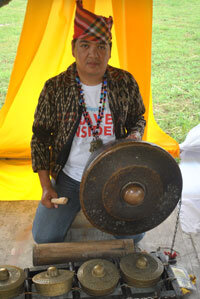Dumaguete: A Genteel Haven from the Pandemic
/Dumaguete at night (Photo by Bernard L. Supetran)
Despite going through the gauntlet just to fly, travel-starved wanderers will go to great lengths for the so-called revenge travel, where they can indulge on their pre-pandemic lifestyle, and perhaps splurge to make up for lost time.
One destination which is quietly beckoning tourists is Dumaguete City, the provincial capital of Negros Oriental, situated in the archipelago’s central islands.
With the streamlined requirements of a negative RT-PCR test result and an online S-Pass from the city government, you make a gentle escape into a Covid low-risk area away from the epicenter of the virus.
And while Dumaguete has the unenviable reputation of recording the first corona virus case from a Chinese tourist in early 2020, it didn’t record an outbreak, and the spread of the disease has been relatively managed well.
Monikered as the “City of Gentle People,” Dumaguete takes pride in its unique blend of Old World charm and tempered modern lifestyle, kindhearted people and genteel way of life. Small wonder it is a sought-after destination by locals and foreigners alike who have been smitten by its eclectic allure.
A few years ago, the city was recognized by the Philippine Retirement Authority as a top retirement area after meeting the stringent global standards of the United Nations and the World Health Organization.
With tree-lined roads, laid-back ambiance, and a sparse population, Dumaguete is an enticing and conducive hideaway when most of the major urban centers are being hit by Covid-19 surges.
With plenty of open spaces and natural attractions in the adjoining towns, it is a safe haven for a physically distanced travel away from the madding crowd. Here, one can safely bask in the grandeur of lush forests, waterfalls, century-old churches, powdery beaches and gin-clear water, picturesque coves, placid lakes, biodiversity-rich dive sites, and everything in between.
Balinsasayaw Lake (Photo by Bernard L. SupetranP
The postcard-pretty Rizal Boulevard, which has a history, is the city’s show window with a promenade which is among the country’s most scenic and vibrant where recreational and sports activities evolve.
Named after national hero Dr. Jose Rizal who briefly strolled on its shores in 1896, the 780-meter road is dotted with ancestral homes and old buildings which have been given a new lease on life as boutique hotels, cafes, restaurants, bars, and commercial establishments.
The Henry Hotel (Photo by Bernardo L. Supetran)
The city government has encouraged the preservation and adaptive reuse of old houses and edifices to make it a heritage village, which blends well with the gentle and genteel character of its people.
No less than its circa-1930s city hall, designed by renowned architect Juan Arellano, was recently restored and is now a branch of the National Museum.
The National Museum in Dumaguete (Photo by Bernard L. Supetran)
At the edge of the boulevard is the sprawling Silliman University, an American-era institution which is recognized as among the best in southern Philippines. It is also an icon of heritage, nature, culture and faith, with its various elements tucked in its 62-hectare soil spread across the city.
Silliman University (Photo by Bernard L. Supetran)
A new bayside spot is the Panilongon commemorative marker which was unveiled in May to mark the 500th anniversary of the Magellan-Elcano circumnavigation, which passed by Negros in 1521 after their debacle in Cebu. Situated at a reclaimed two-hectare park, it has a galleon-themed design and is perhaps the prettiest among the quincentennial markers of the monumental expedition.
Panilongon Quincentennial Landmark (Photo by Bernard L. Supetran)
You can also embrace the local culinary culture with the vast array of restaurants and dishes, from the ubiquitous budbud, the local version of the suman sticky rice, to fried street food on sticks, traditional Visayan delicacies, fusion cuisine, and international dishes cooked by foreign migrants.
But despite this enticing scenario, Dumaguete is encountering the pains of a growing cosmopolis just like other emerging urban centers around the world, particularly during the Covid-19 pandemic.
According to Mayor Felipe Antonio Remollo, the city has cautiously restarted the economy and the tourism industry with its methodical approach in containing the spread of the virus.
He said that despite the numerous challenges, the city is taking a great leap forward through a 174-hectare global township project, whose groundwork began before the pandemic struck. A public-private partnership undertaking, the city government envisions it as a legacy project to create tens of thousands of jobs and income opportunities, particularly for those badly hit by the Covid-19 fallout.
Touted as a smart city, the project will showcase earth-friendly building systems, modern information technologies and transportation, and renewable energy suited for world-class communities.
The master-planned development will house a mixed-use business park, recreational centers, public facilities for health, housing, education, sports, and multimodal mobility, medical and wellness tourism facilities, lifestyle centers, landscaped gardens and greeneries, and retirement residences for those who wish to make Dumaguete their new post-work address.
Remollo concluded that while the project is a bold enterprise, it is a balancing act which involves mitigating the impact on the environment, and appeasing the collective nostalgia of the community and stakeholders for the good old city they dearly love.
For now, the city is happy just being a gentle and safe haven in the time of pandemic.
Bernard Supetran is a Manila-based freelance photojournalist, editor, tourism consultant, and lecturer. He is also a certified open water scuba diver and marine environmental protection advocate and has dived in various parts of the Philippines. In this issue, he features Sarangani Province where he is currently working out his community adoption in an indigenous tribe.
More articles by Bernard L. Supetran









